Green curry is a classic Thai dish that is a staple in Thai restaurants all over the world. You may have tried making the curry using store bought paste, but perhaps it's time to try making it from scratch? There's nothing like eating a curry that you made with your own homemade paste. Once you're done, try making red curry paste next as many of the ingredients are similar.
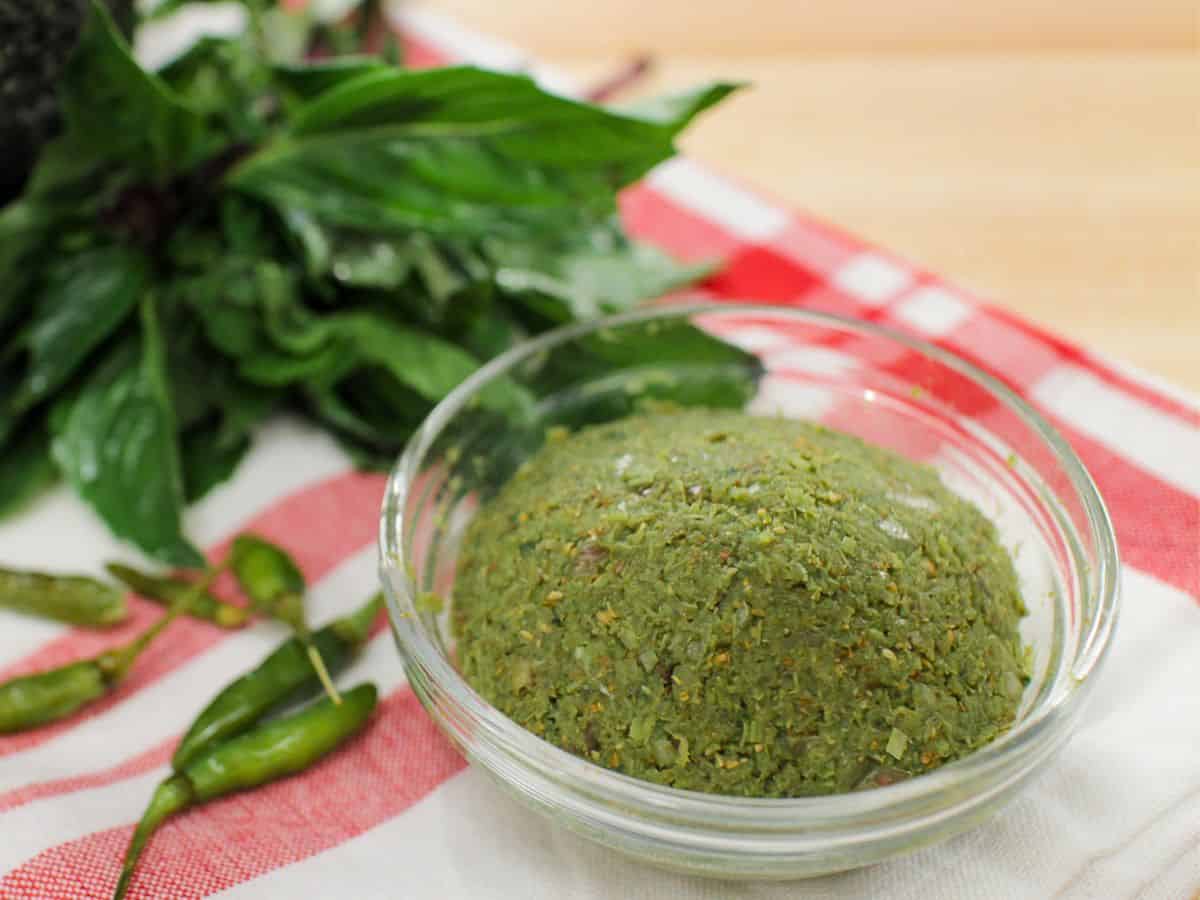
What is Green Curry Paste?
Green curry paste is called พริกแกงเขียวหวาน prik gaeng keow waan in Thai, and it's a paste made from a mixture of herbs and spices, which eventually becomes the base for our famous Thai green curry.
The green colour comes from the use of fresh green chiles, which is unique among most Thai curry pastes which mostly use red dried chilies. These spicy green chiles are also responsible for the distinct fiery flavour of green curry.
Why make curry paste from scratch?
But first, why should you bother making your own Thai green curry paste? There is actually nothing wrong with a good store-bought curry paste, and most Thai people buy the paste premade, too.
So this is something you should do because you want to experience the process and the pride of making something entirely from scratch. It's like making homemade sourdough when you can easily buy one from the bakery down the street.
I will say that it's truly fascinating to see the transformation of the ingredients and the aromas as you go through the process, and it will taste unique, unlike anything else you buy!
Watch The Video Tutorial!
All my recipes come with step-by-step video tutorials with extra tips not mentioned in the blog post, so make sure you watch the video below to ensure success - and if you enjoy the show, check out my YouTube channel!
Ingredients and Notes
Here are important notes on the ingredients. For amounts, see the recipe card below. The biggest hurdle in making any Thai curry pastes is getting all the ingredients you need, particularly the fresh herbs. So locate some good Asian markets in your area that carries a lot of Southeast Asian ingredients, and you can always consult my map of Asian grocery stores to help with that.
- Coriander seeds, toasted
- Cumin seeds, toasted
- White peppercorns
- Thai green chillies or serrano peppers, these are the spicy green chilies that are responsible for the heat of your curry. You can customize the spice level of your paste by adding more or less of these spicy green chilies.
- Milder green chilies such as Korean green peppers or jalapenos. Using both spicy and mild chilies allow us to pack in more chili flavor without too much heat. Korean markets usually have mild green peppers available, and deseeded, de-pithed jalapenos will also work.
- Coarse salt, the coarseness is only helpful in grinding the chilies if you're using a mortar and pestle. Use any salt if using an immersion blender.
- Thai basil leaves, this is added to boost the green colour without adding any more heat from green chilies. Other leafy greens such as spinach will also work, but since you will need Thai basil to make the curry, it's a convenient option. The flavour of the basil will not come through as the paste will be cooked extensively and will cook away most of the Thai basil aroma.
- Lemongrass, for curry paste, do not use dried or powdered lemongrass. Fresh lemongrass is best, but frozen will work. Use only the the bottom half of the lemongrass stalk as it is the most flavourful part.
- Galangal, as with lemongrass, fresh or frozen galangal is best.
- Makrut lime zest (aka kaffir lime zest). You can substitute the zest of half a lime, or if you can find makrut or kaffir lime leaves, you can simply add more of the leaves to the curry itself.
- Cilantro roots or cilantro stems
- Shallots
- Garlic
- Fermented shrimp paste. Called gapi in Thai, this is a salty, funky, purplish-grey paste that is also called belacan (Malaysian) or terasi (Indonesian). It is added to most Thai curry pastes for extra umami, but it is not necessary. For vegans, you can also add 1 teaspoon of miso paste or doenjang, or 1 dried shiitake mushrooms, finely grated with a microplane. You can also omit it and then add more fish sauce or soy sauce to the curry itself.
Want to save this recipe?
How to Make Green Curry Paste
The following are instructions for making green curry paste using a combination of a coffee grinder and a mortar and pestle. You will need a large, stone mortar and pestle (affl.) for this, not a tiny marble one. If you want to use an electric appliance, see below.
- If your spice tolerance isn't high, remove the seeds and pith from some or all of the spicy chilies (Thai/serranos) to reduce the heat, then finely chop them. If you're not sure how much to remove, I recommend deseeding all of them and you can always add more chilies to the curry later if it isn't spicy enough. *You may want to wear gloves when working with chilies, or wash your hands very well and be careful not to touch your eyes afterwards!
- Finely chop all of the other herbs; the smaller they are to start, the less time it will take you to pound them in a mortar and pestle.
- Grind the dry spices into a powder.
- Add all of the chilies and salt to the mortar and pound until mostly fine; if at any point the mixture feels too wet and slippery, add some or all of the dry spices to absorb excess moisture.
- Add the Thai basil leaves and pound into a fine paste.
- Add the lemongrass, galangal, makrut lime zest, and cilantro roots or stems; pound into a fine paste.
- Add the shallots, garlic, and any remaining dry spices and pound into a fine paste.
- Add the shrimp paste, if using, and pound to mix.
What's the best tool for making curry paste?
In the video tutorial I show you the traditional method using a mortar and pestle. But I have to stress that you need a big, sturdy granite mortar and pestle for this, otherwise it will be immensely frustrating. So don't use that cute little marble one!
Using the mortar and pestle may not be the "best" way to make curry paste if you won't have enough patience to pound it until it's very fine. Keep in mind it will be a bit of a workout.
If you need some electric assistance for this job, here are my suggestions:
- For the dry spices, use a coffee grinder to make sure they are very fine. Grind them separately regardless of what machine you want to use for the paste, and you can add the spices to the paste at any time during the process.
- My personal favourite tool is a powerful immersion blender. This is because it can blend a small amount of ingredients and it can tackle a low-moisture paste like a curry paste. Here's the immersion blender I use and recommend (affiliate).
- If using a jug blender, I suggest making at least a triple batch to give it enough volume to blend, and you will need to add a little liquid to get it to blend properly. Water is fine, but if you're making a green curry with this paste, you can also add some of the coconut milk called for in the green curry recipe. Note: Adding coconut milk to the curry paste shortens its shelf life significantly so I would freeze it if not using right away.
- Food processors are not ideal as they don't get the paste as fine as I like, and you would need to make a big batch in order for it to process properly.
How to Store Curry Paste
- If I don't have any plans to use it within a few days, I always freeze my curry paste. If keeping in the fridge, store in an airtight container.
- For convenience, freeze them in portions - however much you will use for a batch of curry. Or if you will make different things from the paste, you can also freeze them into little blocks in an ice cube tray so it's easy to take the amount you need.
How to Use Green Curry Paste
Now that you've got some fresh curry paste, let's put it to use! In THai cooking, we use curry pastes in more than just Thai curries, it's quite a versatile paste so think of it as a "flavour paste" rather than strictly a curry paste. Here are some things to try:
- Thai green curry chicken or vegan green curry - the most obvious use of your curry paste is in a classic curry! What I love about this recipe is that it's very simple yet so tasty. I use bamboo shoots as the vegetable, which come ready to use from a can, making this a weeknight-friendly meal.
- Green curry fried rice - a different way to enjoy the flavour of green curry! Try it, and you'll be blown away. Use whatever veggies you like, but bell peppers, green beans and carrots all work well. Makrut lime leaves brighten up the dish with citrusy aroma, so don't skip it if you can!
- Green curry spring rolls - green curry paste can be used to flavour meat mixtures, such as spring roll fillings. It'll be a total crowd pleaser at a party!
Recipe Card
Print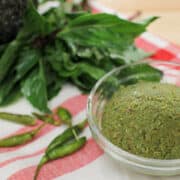
Thai Green Curry Paste Recipe
- Prep Time: 15 mins
- Cook Time: 20 mins
- Total Time: 35 mins
- Yield: Serves 4-6
Description
Authentic recipe for a homemade Thai green curry paste for the DIY minded. Once you have the paste, use it in this Thai green curry recipe.
Ingredients
Want to save this recipe?
- 2 tsp coriander seeds
- 1 tsp cumin seeds
- ½ tsp white peppercorns
- 15 g green Thai chilies or serrano peppers
- 15 g milder green chilies (see note 1)
- 1 tsp coarse salt
- 15 Thai basil leaves, julienned (optional, see note 2)
- 3 Tbsp thinly sliced lemongrass, from bottom half only
- 1 ½ Tbsp finely chopped galangal
- 2 tsp finely chopped makrut lime zest (or zest of half a lime)
- 2 cilantro roots or 4 cilantro stems, finely chopped
- 3 Tbsp finely chopped shallots
- 2 Tbsp finely chopped garlic
- 1 tsp fermented shrimp paste (optional, see note 3)
Instructions
If your spice tolerance isn't super high, remove the seeds and pith from some or all of the spicy chilies (Thai/serranos) to reduce the heat, then finely chop them. If you're not sure how much to remove, I recommend deseeding all of them and you can always add more chilies to the curry later if it isn't spicy enough. *You may want to wear gloves when working with chilies, or wash your hands very well and be careful not to touch your eyes afterwards!
If using a mortar and pestle:
Grind the dry spices into a powder, then remove and set aside.
Add all of the chilies and salt to the mortar and pound until mostly fine; if at any point the mixture feels too wet and slippery, add the dry spices to absorb excess moisture.
Add the Thai basil leaves and pound into a fine paste.
Add the lemongrass, galangal, makrut lime zest, and cilantro roots; pound into a fine paste.
Add the shallots, garlic, and any remaining dry spices and pound into a fine paste.
Add the shrimp paste and pound to mix.
If you want to use an electric device, see blog post above.
Notes
- Using both spicy and mild chilies allow us to pack in more flavor without too much heat. Korean markets usually have mild green peppers available, and deseeded jalapenos will also work.
- Thai basil is added to boost the green colour without adding any more heat from green chilies. Other leafy greens such as spinach or gailan will also work, but since you will need Thai basil to make the curry, it's a convenient option. The flavour of the basil will not come through as the paste will be cooked extensively and will cook away most of the Thai basil aroma.
- Shrimp paste is added for extra umami, but it is not necessary. For vegans, you can also add 1 teaspoon of miso paste of doenjang, or 1 dried shiitake mushrooms, finely grated with a microplane.

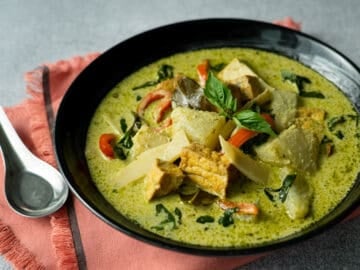
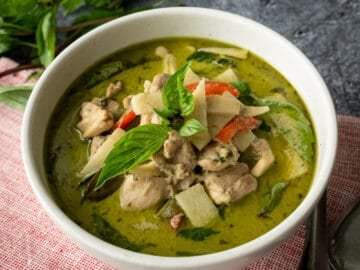
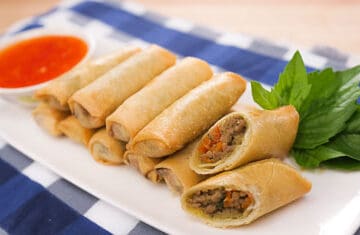
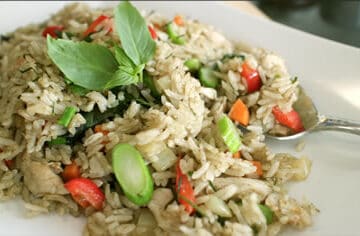
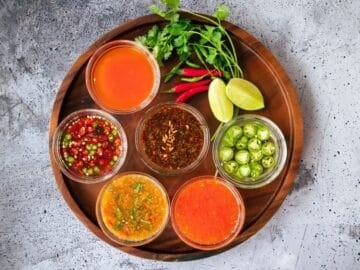
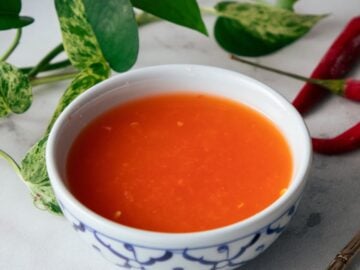

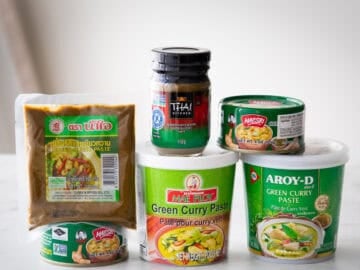
Pili says
Several years ago I was watching videos on how to make curry paste from scratch. There was this beautiful, young, sassy girl from Canada that was explaining it thoroughly. I found her videos educational, and I found her personality enjoyable.
Recently I was searching you tube for ideas for something to make. Often I do this by checking out vegetarian recipes from someone that cooks a particular ethnic group I am hungry for. This is where you came in. I then looked back at some of your early videos and realized I was watching that same beautiful girl all grown up! You are still just as lovely today!
The best thing I learned from you was which coconut milk to buy. I would have never known what a huge difference it made.
Lucky for me I was always a Mae Ploy curry paste purchaser, but it was fun to watch how the ones I have tried ranked in the same order as you ranked them.
All those words just to say thank you for sharing your joy. 🙏
Kathryn says
Have just made this and have not tried it as yet, but it does smell amazing. An FYI though, it does take much longer to prepare than stated. You have to wash herbs, wash and if required, deseed pepper, peel shallots and garlic. Once you have your mise en place it will still take around 2 hours minimum to complete. Looking forward to tasting the recipe.
Alex says
I made this last week although I couldn't get makrut limes, galangal or coriander (cilantro) roots. I used normal lime zest, galangal paste and coriander stems instead. I have to say the result was still fantastic.
I have since made a bulk order of the things I didn't have and was wondering if it is better to make a large batch of paste by multiplying the recipe and freeze the paste or to freeze the individual ingredients (coriander roots, limes, galangal, chillies, etc.) and use them to make one serving of paste each time? Which freezes better?
Denny K.L says
As a Thai Foods Lovers, I’m very picky when comes to finding a good Thai Restaurant which serves authentic Thai cuisines. I’ve been following Pailin for almost a decade now; I must say she’s one of my online Thai Foods Teachers whom I trust when comes to making good Thai Foods.
I’ve made this Thai Green Curry Paste with a twist by adding more Thai Green Chili Peppers as I love spicy food. It turned out quite good, thanks Pailin.
I’m your fan from Indonesia.
Ken says
Didn't this recipe originally (2019) call for 1 tablespoon of Shrimp paste?
Dora Shen says
Hi! I love this recipe and I'm doing a cookoff with some friends this weekend and want to use this green curry paste recipe (and your green curry recipe). I want to make a grocery list and it is hard to shop for grams of each ingredients. Do you think you could list out the ingredients in per item? For example # of green chillies, # of lemon grass, etc.
Nellie says
Would adding kaffir lime leaves directly into the paste make the paste bitter (I used a blender to make a fine paste)? Also how many leaves would you recommend adding into the paste before blending? Thank you!
Pailin Chongchitnant says
It'll be fine. I'd say 2-3 leaves per batch is probably enough.
Pailin Chongchitnant says
Hi, you were reading the ingredient notes section, the amounts are listed in the recipe card at the bottom of the pot. There is also a "jump to recipe" button at the top of the post to skip the explanations.
Mark Hagopian says
Thank you for your great recipes! I made this recipe using my old Krups coffee grinder and it produced a beautifully smooth paste so I’m not sure why so many sources say a coffee grinder won’t produce a fine enough result. I first made your Thai green curry using jarred green curry paste and the results were good but the homemade paste brought my second attempt to a new level in terms of complexity and nuanced flavors- definitely worth the extra 10 minutes work. I made a few substitutions for convenience: red Thai chilies instead of green, fresh ginger for galangal (I can get galangal but it’s very expensive and prepackaged in larger quantities than I would ever use), ground cumin and white pepper rather than whole, regular lime zest, and anchovy paste instead of shrimp paste. I also added some cilantro leaves for extra color and a fresh taste, and didn’t use mild peppers, which I think was my only mistake since the paste was delicious but quite spicy, although the high heat didn’t overwhelm the other flavors. I’m going to try your green curry fried rice with the leftover paste.
Eve says
I've made this three times now and absolutely love it! However, it always takes me 2+ hours to chop up and mash everything so make sure you have plenty of time to work because 35 minutes just isn't realistic if you're trying to get a smooth paste.
Victor says
I've been making this great green curry paste from scratch for months, and it beats any store bought curry paste. I love the other curry pastes too. Thank you Pai !
René says
I do green thai curry paste on my own since years. The receipe is similar as I do. Buying green thai curry paste on supermarket is no alternative anymore. The taste and the light / lime green color of the dish cannot be replaced. Love it!!!
Winnie says
There is a galangal powder in the Asian grocery store for those who find hard to chop. I put thinly sliced lemon grass, garlic, shallots or green onions and cilantro into the blender with coconut milk which gives a green color. You can use the outer lemon grass hard portions, by pounding a few times with mortar and pestle and put it when cooking the coconut milk to become thick. It will give you the flavor but discard afterwards.
There is also lemon grass powder or frozen chopped lemon grass in some Asian grocery stores. It is also handy when you can’t go to the store to get a fresh one.
Anissa says
Perfect recipe and authentic ! Thank you for sharing.
Bob says
The curry paste turned out VERY flavorful, but I made a couple of mistakes. I was afraid it was going to be too spicy, so I de-seeded all the green thai chilis, and it actually turned out too mild. Next time I'll try leaving the seeds in 1-3 chilis. I also found out that fresh Kaffir lime leaves are REALLY tough, and I couldn't get them to pulverize no matter how much I pounded them. Next time I'll put them in the mortar first, along with the coarse salt.
Gwynneth says
Hi Bob I have just made my own green curry paste for the first time. I just added the Keffir leaves whole as an infusion ...take out before serving. This is what I read to do. The galangar (ginger) immensly hard to chop -not sure of any tips tho. I put all the ingredients in the nutri-bullet with the lime juice and it turned out quite good lol if I say so myself as I am not an enthusiastic cook.:)
Lily Hoang says
Where do we get cilantro roots or stems?
Adam from HTK says
Anything near you on the map here? https://hot-thai-kitchen.com/locate-a-thai-grocer/ Good luck! Adam
Laura says
Cilantro (and included stems) is available in the produce department at most grocery stores.
Theodore says
Missing an ingredient at the end
Lionelion says
I noticed the same. Comparing with other recipes, I think it's garlic. That's what I'm going to put in anyway. We shall see (and smell).
Pailin Chongchitnant says
Yes, garlic is absolutely correct. Sorry about that!
Pailin Chongchitnant says
Oops! It's garlic 🙂 Sorry about that!
Shakira says
What was it Theo
Lionelion says
Having problems with the second-to-last ingredient. What word is missing?
Or should i be chopping the tablespoons themselves.... my wife won't like that.
David says
Hi If I want to make a big batch for freezing do I just double/triple all the ingredients?
Thanks
David
Pailin Chongchitnant says
Yup, just multiply everything proportionally.
Claudia says
HI David, I've been making red curry paste for a long time now.
As it takes time to make yes I definitely make triple batch and freeze it . Works wonders for me .
Roscoe says
Can I use regular basil instead of thai basil?
Pailin Chongchitnant says
Yes
John Miller says
Can I substitute kaffir lime leaves for kaffir lime zest in this recipe? The lime fruits are impossible to find this time of year, but the leaves are fairly obtainable.
Pailin Chongchitnant says
You can just omit it and you can add some extra leaves when you make the curry itself!
Nichole says
I have made the vegan version of this paste a few times now (which we love - thank you!), and while I see you have a vegan Red Curry recipe, I don’t see a vegan Green Curry one. Do you basically use the recipe for the Red Curry, minus the meat and tomato paste? Or, is there a recipe you especially appreciate? I’ve checked through many comments, and just haven’t seen anything mentioned. Thanks so much!
Pailin Chongchitnant says
Thanks Nichole! I don't have a vegan green curry recipe yet as I"ve never personally made one myself. But I'll add that to the list of things to do 🙂
Mario Henneberg says
What kind of thai basil do you use?
Pailin Chongchitnant says
Not sure what other kinds you're thinking of, but it's the one that shows up when you google image "Thai Basil." In Thai it is called Horapa.
Anand says
Is there a vegetarian replacement for the shrimp paste?
Manu says
Use a bit of miso paste!
James says
Hi, how much of this paste serves a dish for 4? (Proportionate to a 400ml can of coconut milk)
Thanks
Pailin Chongchitnant says
You can use all of it for a 4-serving curry, but if spice tolerance is low, maybe start out with ¾ of it.